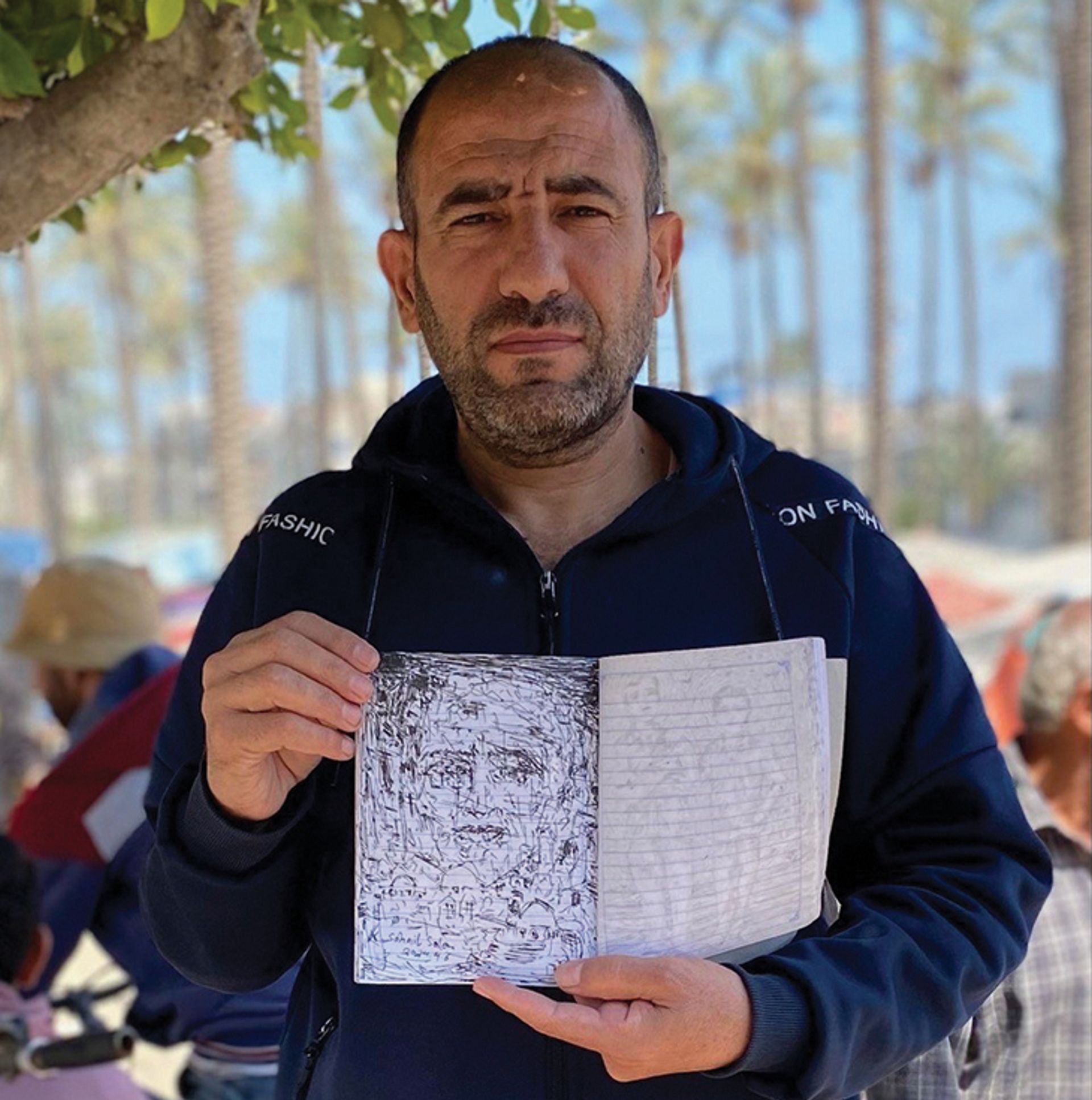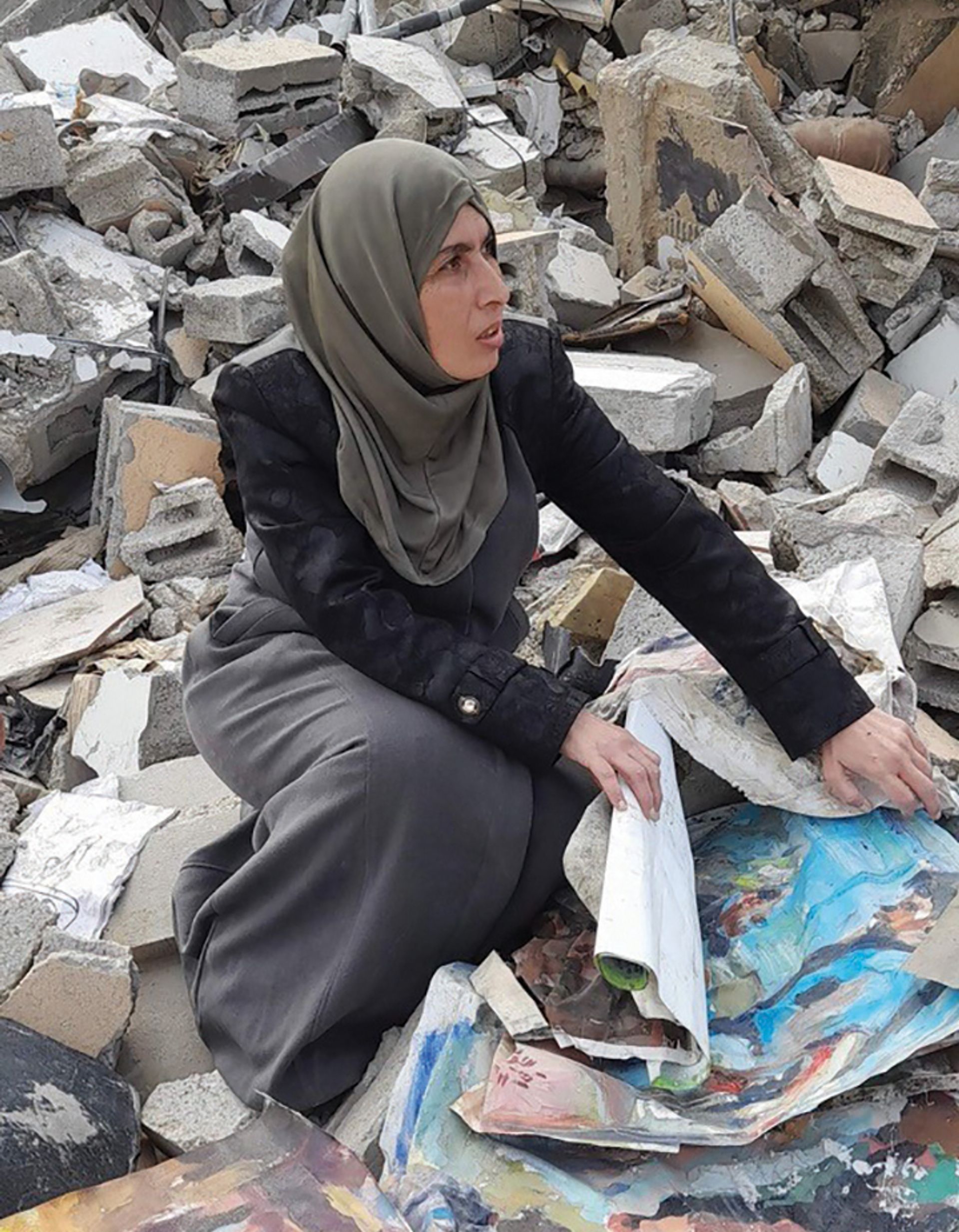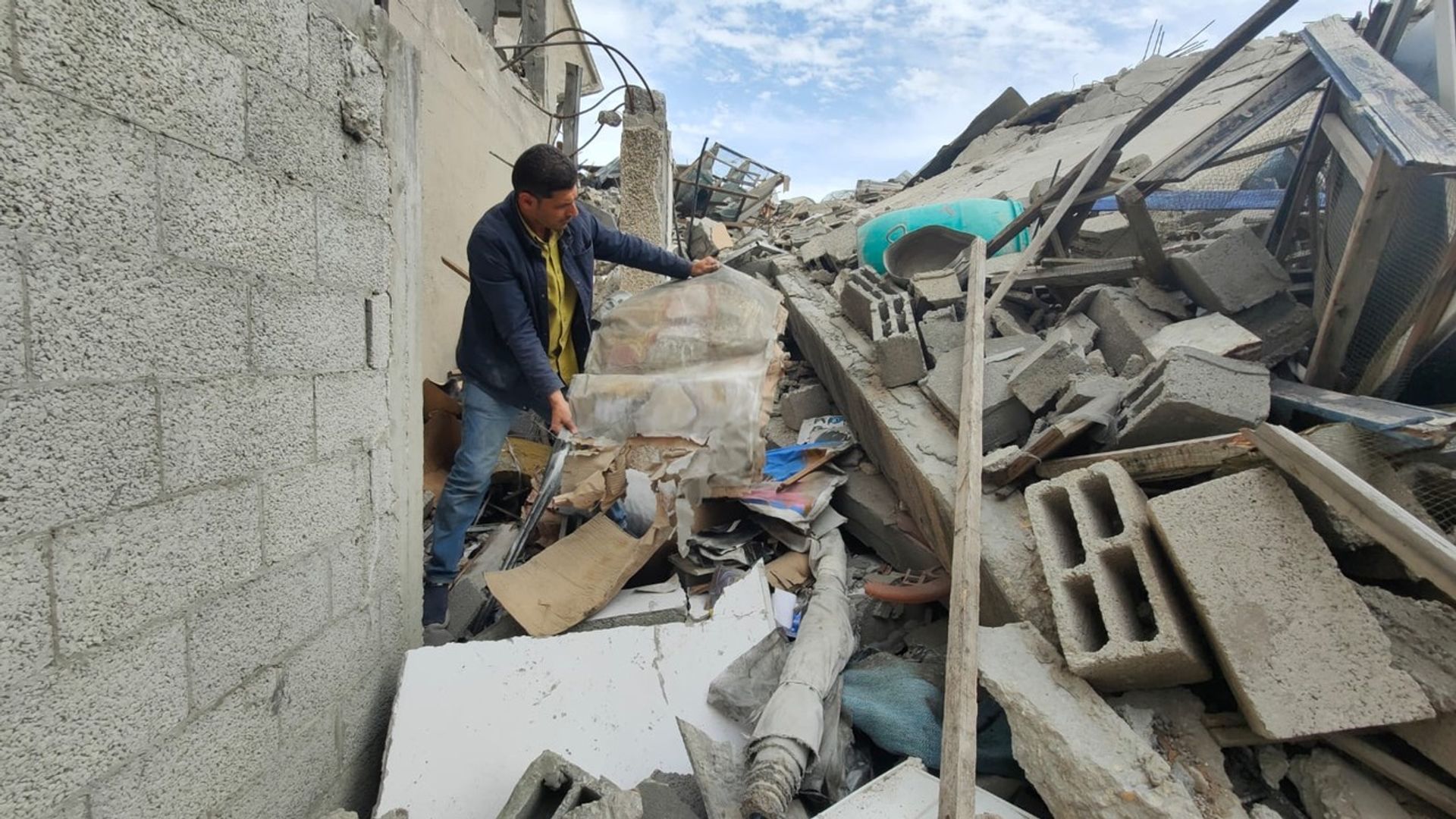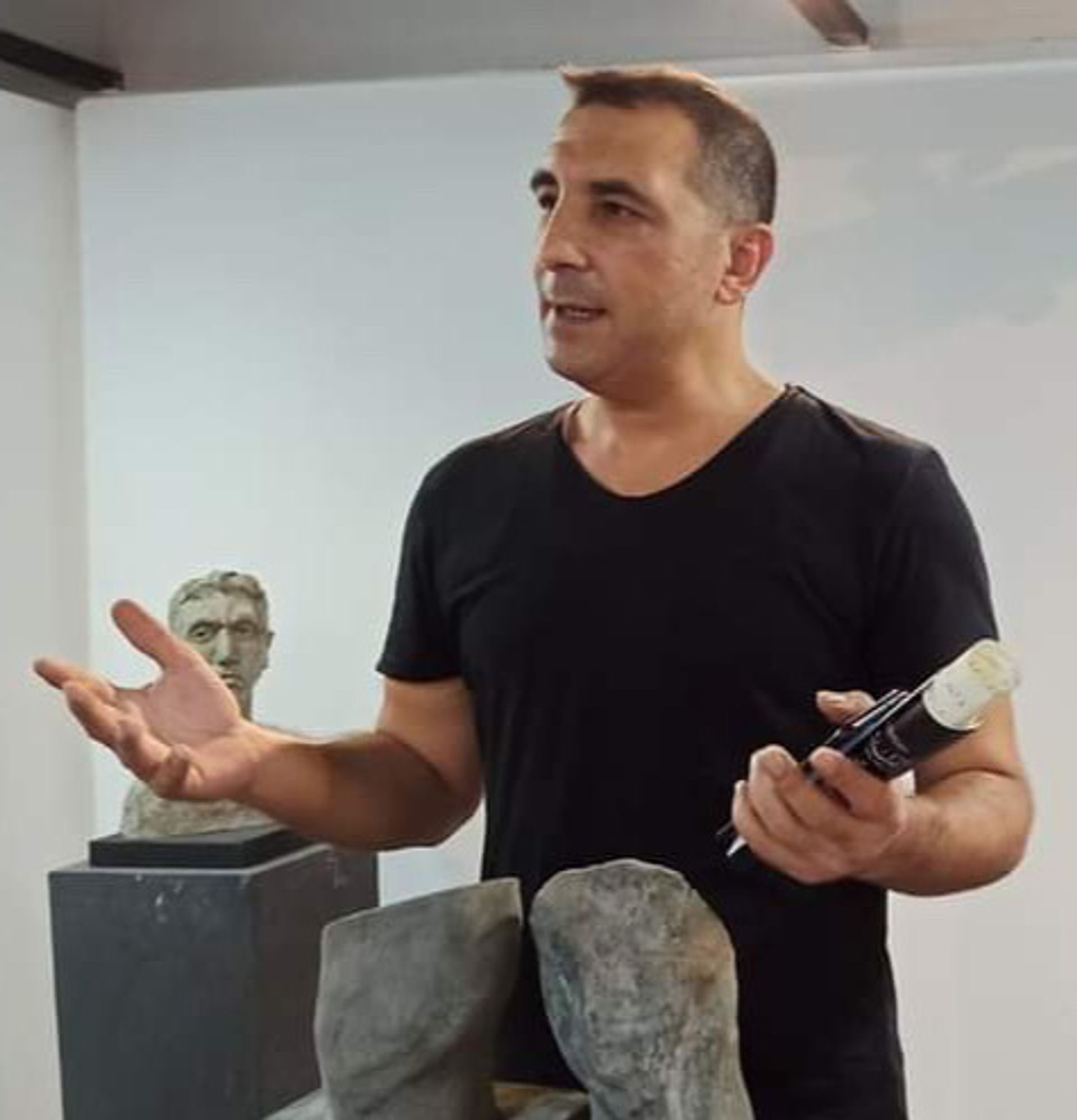Access to formal arts education in the Gaza Strip was limited until the mid-1990s, when Al-Aqsa University established the territory’s first art courses and college of arts. Despite this late start, the arts scene in Gaza experienced rapid growth, fostering a vibrant community of creatives from diverse backgrounds. In 2002, a group of seven artists established the first contemporary art space in Gaza, Eltiqa Group for Contemporary Art, known as Eltiqa. It aimed to nurture the talents of young artists through mentorship and free studio spaces.
Until 2007, artists had a small number of opportunities to exhibit their work in the West Bank. However, after Hamas’s takeover of the Strip, and the tightening blockade by Israel and Egypt in the ensuing years, these opportunities—along with public funding for the arts—dwindled. Materials became scarce, forcing artists to make do with whatever resources they could find. In 2009, these restrictions prompted another group of artists to establish a visual arts space, known as Shababeek. Despite this resilient art scene, there was little financial stability for artists in Gaza, and most held day jobs to sustain themselves. While a few other art spaces emerged over time, Eltiqa, Shababeek and Al-Aqsa University remained the backbone of Gaza’s visual arts scene; all three have been destroyed since the outbreak of war in October last year.
According to a report by the Palestinian ministry of culture in February, 32 cultural institutions were damaged or destroyed during the first four months of the war. We spoke with six artists who have been active participants in Gaza’s art scene to discuss their experiences during these turbulent times and their perspectives on the future for the arts in Gaza.
Basel El Maqosui, artist, photographer, teacher and co-founder of Shababeek
Basel El Maqosui has lost everything: his home in Beit Lahia, close to the border with Israel; his art centre, Shababeek; and a lifetime of work, including his large archive of photographs and cameras. Yet, amid the wreckage and devastation, El Maqosui finds refuge and purpose in his art, using drawing to navigate the tragedies that have struck him, including the loss of family members and friends. “I try to preserve my humanity and take advantage of every moment in which I am able to draw,” El Maqosui says.
The award-winning artist and father of five moved from one city to another several times before finally settling in Rafah. With over 25 years’ experience working with children, especially those with hearing disabilities, he was disheartened to witness their plight under constant bombardment. He became concerned for the wellbeing of the children, surrounded by destruction, and burdened with tasks like sourcing water and food. “They do work that is not their work,” El Maqosui says. “They have the right to play, draw, learn and be healthy, just like other children around the world.”
He bought paper and paints, then walked around the tents inviting children to join him, eventually organising small workshops with them. Mothers, observing the positive impact on their children’s behaviour, asked El Maqosui to do workshops for them as well. “It was one of the most difficult workshops in my life,” he recalls. “They were drawing their dreams, crying, and I was crying with them.”
Drawings from El Moqosui’s workshops, which are often uploaded to his Facebook, attracted the attention of prominent art organisations such as the Al Qattan Foundation for Culture and Arts, Dar Al-Kalima University, and Hope and Play charity, all of whom have stepped forward to support his endeavours.
“Art and drawing are the language of peace, love, and life. Drawing and playing with children is the only weapon I have to resist and improve the conditions in which we live,” he says.
I draw while the sound of bombing and planes never ends
Basel El Maqosui
In April, after Israeli forces withdrew from Al-Shifa hospital and its surrounding area, it was revealed that Shababeek, and its collection of 20,000 works, including El Moqosui’s art, had been destroyed. “It [Shababeek] was a destination for Gaza,” says El Moqosui, adding that the space attracted visits from international institutions and became a centre that worked on changing the community’s culture. “We always worked to raise the cultural and artistic level of artists and the public.”
Despite the tremendous loss he has experienced, he is steadfast and believes that the arts will prevail. “Here I am, despite all this war and genocide that we are exposed to, but I draw while the sound of bombing and planes never ends,” he says.
Leaving Gaza is out of the question as it is just too expensive, he says. While he hopes the war will stop, he is not surprised that Israel did not implement UN’s March resolution that called for an immediate ceasefire. “If Israel had adhered to and implemented United Nations resolutions, we, as Palestinians, would not have been under occupation for more than 75 years.”

Sohail Salem, displaced to Deir al-Balah, shares his daily sketches on Facebook Sohail Salem
Sohail Salem, artist and co-founder of Eltiqa Group for Contemporary Art
To cope with the harsh realities of living in a war zone, Sohail Salem, a resident of Gaza City’s al-Rimal district, has found solace in drawing. He shares his works as a form of diary on Facebook.
His neighbourhood, located in the centre of Gaza City, was among the first to be targeted by Israel’s military when the conflict began last year. After receiving the army’s evacuation orders, the 47-year-old father of five moved his family to another home in the south of the city. Despite evacuation orders to leave for cities like Rafah, Salem and his family decided to stay put, surviving several bombings that claimed the lives of some of their neighbours. “After the army withdrew, we saw the scale of the disaster, the bodies in the streets, and the destruction of shops and properties,” Salem recounts.
On 18 January, the sound of violent bombings in the area and the screams of people nearby signalled the return of the army. Soon, soldiers called for people to gather in the street, where everyone in Salem’s family, including his wife and their 15- and 11-year-old children, had their hands tied, he says. Salem’s wife and children were released and ordered to travel to Deir al-Balah in central Gaza, via Gaza’s coastal road, while Salem was blindfolded and taken away for interrogation. “I did not think about what was happening to me, but I was saddened for my children as they watched me get blindfolded and taken away,” Salem says.
I was saddened for my children as they watched me get blindfolded and taken away
Sohail Salem
After several hours of questioning, during which he was asked about “military matters” that he knew nothing about, Salem was released and instructed to also head to Deir al-Balah, a journey of 16km that he completed by foot. “I saw bodies lying on the road. I thought about my children and my wife, and I was saddened that they would have seen these tragic scenes,” Salem says. It was two days before he found his family. Their abrupt departure meant they were left with no material possessions—no money or clothes.
“Everything happened so quickly,” Salem says. Kind-hearted individuals in the city helped, providing the family with essentials, while Salem found a shop for them to live in. His life today is a far cry from the one he led before the war, lacking access to necessities such as gas, electricity, internet and water.
Before the war, Salem was a recognised figure in Gaza’s art scene and a co-founder of Eltiqa. Despite the challenges of travelling from Gaza, he secured several prestigious art residencies in Jordan, Switzerland and France. At the end of March, a show of his work and his fellow Eltiqa founders, titled Is there a tomorrow for Palestine? Gaza seven painters exhibition, took place in Japan—without him. He could only catch a glimpse of his exhibition through images shared on Facebook. “The life of a Gazan artist is not easy, as we are often isolated from the world,” Salem says. “But art serves as the bridge between us and other people.”
Although Salem draws in his notebook daily, he says there is never enough time or peace for this activity. Every day he awaits news of a ceasefire, longing for the opportunity to return home.

Ruqaia Alulu recovered just 33 of her 800 paintings from the rubble of her apartment in Bureij Ruqaia Alulu
Ruqaia Alulu, artist and art teacher
In 1993, facing a lack of art courses in Gaza, Ruqaia Alulu managed to secure a permit from Israel to study photography at An-Najah University in Nablus. Later, she obtained a master’s in Cairo and went on to work as an art teacher. Alulu had her first solo show in 2012 at Eltiqa and later held exhibitions at Shababeek. But when war reached her home in Bureij, central Gaza, in December, she was forced to flee. Accompanied by her mother and sisters, Alulu sought refuge at a nearby United Nations school for 60 days. At the school they endured appalling conditions that she says were worse than those of prisons. Hygiene “was non-existent”, with limited water and bathrooms that had to be shared by hundreds of men and women, causing long queues and “unbearably” long waits. The canned food provided had no nutritional value, and rice was distributed raw, leaving women with the daunting task of building fire to cook it. Children’s screams of fear at night added to their ordeal.
After two months, Alulu returned to her apartment to find it had been destroyed by an air strike. “Everything was lost,” she says. “A part of me is lost.”
The family has opted to stay at her late father’s damaged home, which lacks windows, doors, electricity and water. “The situation is catastrophic and completely inhumane. You feel like you are living in a shallow swamp” she says. “You cannot believe what is happening to you.” They have covered the windows and bullet holes with paper to obtain some sense of privacy.
Looking ahead, Alulu plans to rebuild her studio and continue painting, depicting Palestine and its scars. She struggles to eat—most days she can only bring herself to eat half a loaf of bread. She finds comfort in drawing, but the results frighten her as they mostly feature skulls and children without eyes or limbs. Nevertheless, after the war she plans to use the drawings as the foundation for her future paintings. “All the colours are under the rubble,” she says. “There are no colours left.”

Mohammad Abusal pulling his artwork from under the rubble
Mohamed Abusal, artist and co-founder of Eltiqa
Mohamed Abusal’s voice is hard to discern through the constant hum of nearby drones. “They are non-stop; we feel stress all the time,” he says. Abusal had to leave his home in Bureij, leaving behind most of his belongings except for a handful of vital documents, a few rolls of his paintings and his laptop. He was displaced multiple times before eventually reaching Deir al-Balah, in central Gaza, seeking refuge in tents, schools and friends’ homes along the way. “All our moves depend on what the Israeli army asks us to do through flyers,” he says. “They distribute them through a special drone and sometimes we receive text messages.”
Preferring to remain closer to his town, Abusal opted against seeking refuge in Rafah. Since the war began, life has been anything but normal. Living in crowded conditions without peace or privacy has become Abusal’s harsh reality, exacerbated by the skyrocketing prices of basic necessities. Items such as coffee, milk and eggs are luxuries that he has not seen for over two months. “I spend all my time just finding water and food, and move from one place to another depending on the situation,” he says.
I felt scared and lost, and asked myself, what about our plans?
Mohamed Abusal
Simple tasks, such as charging his phone, demand careful planning because of the lack of electricity. This often entails sending his mobile to locations with solar power for charging, resulting in extended periods without access to a phone.
A brief opportunity to return home revealed the devastation caused to his apartment in a three-storey building, obliterated by an airstrike. “It was a big shock when I saw it,” he recalls. “Everything was destroyed and all my artworks were damaged.”
In addition to supporting home-grown talent in Gaza through Eltiqa, the 48-year-old sought recognition for his own work, participating in international events like Documenta 15 as part of The Question of Funding, a collective of cultural producers and community organisers from Palestine. (Controversy tarnished the show when the collective member Mohammed Al Hawajri’s collages, titled Guernica Gaza, were caught up in an antisemitism row.)
Eltiqa was destroyed in a bombing in December. “Eltiqa was the main art station for all young artists in Gaza,” Abusal says. The space was more than a place for exhibitions; it was the place for people “to recover from the stress and the dirty political situation. We had a beautiful life”.
Its destruction left the father-of-five heartbroken. “I felt scared and lost, and asked myself, what about our plans? What about the collection there?”
The loss of his home, his life’s work and the destruction of Eltiqa have shattered Abusal’s hopes of rebuilding life in Gaza. “I’ve lost my hopes and ambitions,” he says. “It’s normal to lose some details in anything, but to lose the main and important plans, it’s horrible and unbelievable.”
Majdal Nateel, artist based in Sweden
Majdal Nateel was a prominent figure in Gaza’s art scene, exhibiting her work in international exhibitions and actively participating in local events. Her debut exhibition in Gaza, hosted at Shababeek, laid the groundwork for her career, opening doors to further opportunities.
Nateel has experienced several wars while growing up in Gaza. She was pregnant in 2014 when a 50-day war erupted, and her health was put at risk when an explosion occurred just a few meters from her house. She had to travel to Al-Shifa hospital in Gaza City regularly for check-ups, where she witnessed horrific scenes. She also assisted people seeking refuge in shelters, which was equally distressing.
The experiences traumatised her so deeply that it would take seven years for her to find happiness and “love Gaza” again. However, when war broke out again in 2021, it reignited all the suppressed memories, prompting her to decide it was time to leave. “I felt my life and my kids’ lives were not important.” In 2022 she left Gaza for Sweden where she now lives and works.
When the war in Gaza began in October last year, she was unable to detach herself from the images emerging from the Strip. “My body was responding like I was in Gaza,” she says. “You remember the feelings, the voices, the smells, the smell of blood.”
She is in a constant state of stress. She has already lost several close family members in this war and been in contact with friends whose children have faced amputation. Her family has lost their home and has been displaced several times, prompting them to decide to leave Gaza to save their lives. But the price of leaving is hefty. A journey that used to cost approximately $200 per person now costs several thousand, so Nateel requires €67,000 (approximately $72,000) for her eight family members to reach safety. “We have to buy our lives,” she says sombrely.
Unable to afford the exorbitant cost, Nateel, like many other Palestinians, has set up a GoFundMe page that she has shared on her Instagram. But she is far from her goal, having only raised around €7,800 (approximately $8400) so far.
“Never did I imagine that I would be asking people for money for my family to leave Gaza,” she says. She has no answers for her family who ask her when they will be able to leave.
While she hopes the war will stop, she regards the notion of a ceasefire as a “joke”. “A normal situation would be to be without occupation,” she says, emphasising that as long as Gaza and Palestinians remain under occupation, it is only a matter of time before the next war begins.
She also notes the disparity in international support from the arts community, observing how Palestinian artists, unlike their Ukrainian counterparts, receive minimal attention and opportunities. “You can see how may Ukrainian artists have opportunities (in the West). There is a hierarchy and in the last place there are the Palestinians.”

Khaled Hossein, artist and government employee
Khaled Hossein embarked on his artistic journey in 1996 as one of the inaugural students of Gaza’s newly established art degree programme at Al Aqsa University. Having lost his father at the age of four he was the primary provider for his family and self-funded his university education. Hossein had a talent for sculpting, with his skills being recognised by the dean of the college of arts, who exhibited his 2m-tall sclupture prominently within the university grounds. However, due to criticism and negative feedback from more conservative students, who viewed his work as anti-Islamic, Hossein dismantled the sculpture after just one week.
After graduating in 1999, he opted for more conventional employment, including government positions, rather than pursuing his passion for the arts. It was not until 2015 that he returned to the art world. “But throughout this period, before 2015, I followed the developments in art and therefore I came back strong.”
In 2015, he co-founded the Kayan Rafah visual arts collective in his home town of Rafah. But despite the initial momentum, the challenges of life in Gaza brought about its closure within a few years. His breakthrough came in 2019 when he held his first sculpture exhibition, I Miss You Very Much at Shababeek.
Hossein continued to make art, adding painting to his portfolio to allow for greater accessibility to the art world beyond Gaza’s borders. “I had difficulty participating in sculpture exhibitions outside of Gaza,” he says, “because of the difficulty in transporting sculptural works.”
Subsequent exhibitions in 2020 further solidified his presence in the local art scene. “Being an artist in Gaza does not mean making sales. Just practicing art. If you make sales, it would be good, but selling is not the main goal.”
However, the father of four’s life and priorities have now changed. With schools closed for the past six months and uncertainties surrounding when they will reopen, he no longer thinks it is possible to live in Gaza. With two of his children outside of Gaza already, he is planning on sending his other children to Europe to study.
“I want to send all my children abroad because there is no future in Gaza, and then I will join them and devote myself to art.”
